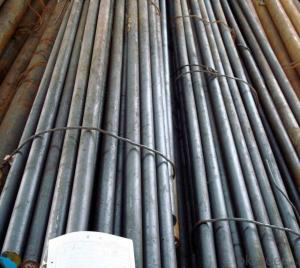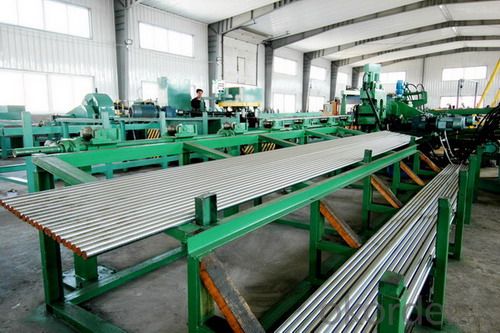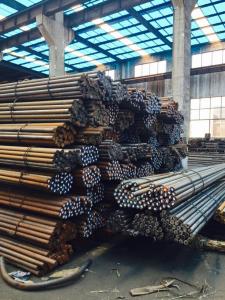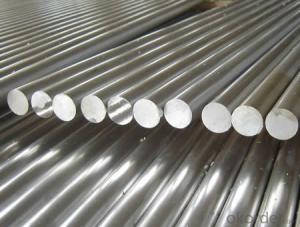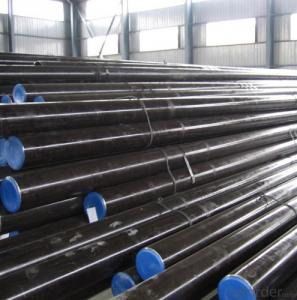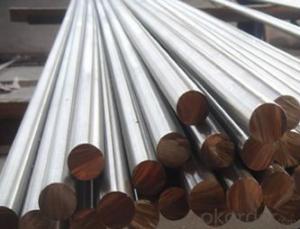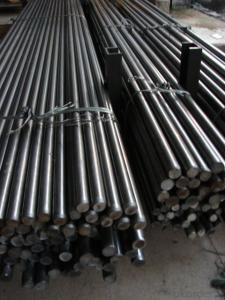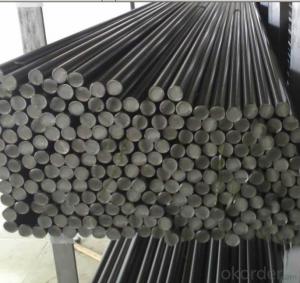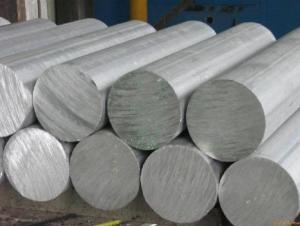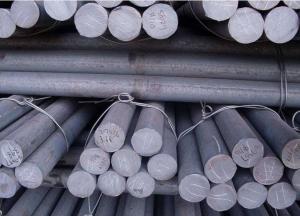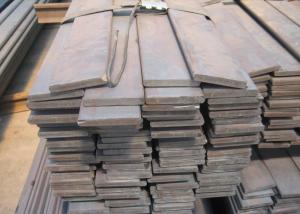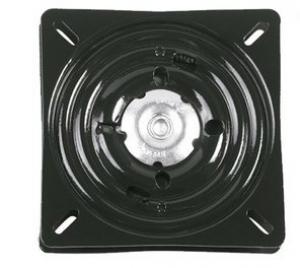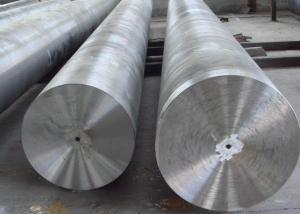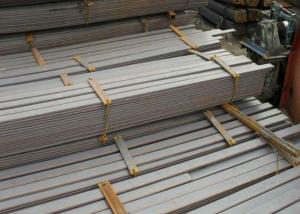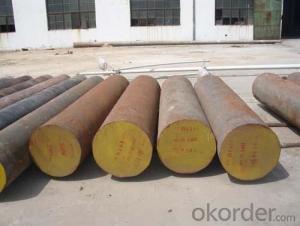High Quality Spring Steel Round Bar 8-10mm
- Loading Port:
- China main port
- Payment Terms:
- TT or LC
- Min Order Qty:
- 100 m.t
- Supply Capability:
- 10000 m.t/month
OKorder Service Pledge
OKorder Financial Service
You Might Also Like
High Quality Spring Steel Round Bar 8-10mm
Product Description:
Spring Steel can be divided into two types. One is carbon spring steel, and other one is alloy spring steel.
Alloy spring steel is based on carbon spring steel, by adding one or more alloying elements to improve the mechanical properties, hardenability and other properties to meet the requirement for manufacture all kinds of spring steel.
Specification of High Quality Spring Steel Round Bar 8-10mm:
-Material: 1065
-Standard: ASTM
-Production: Hot rolled or cold rolled
-Type: Spring Steel
| Diameter(mm) | Mass(kg/m) | Section(mm2) |
| 8 | 0.395 | 50.24 |
| 9 | 0.499 | 63.585 |
| 10 | 0.617 | 78.5 |
Corresponding Steel Grade of High Quality Spring Steel Round Bar 8-10mm for Reference:
USA, ASTM | CHN, GB/T | JPN, JIS | ISO |
1065 | 65 | SWRH67A SWRH67B | Type SC Type DC |
FRA, NF | GBR, BS | ||
C66D | C66D |
Chemical Composition of High Quality Spring Steel Round Bar 8-10mm:
C | Mn | Ni | Si |
0.62~0.70 | 0.50~0.80 | ≤0.30 | 0.17~0.37 |
P | S | Cr | Cu |
≤0.035 | ≤0.035 | ≤0.25 | ≤0.25 |
Mechanical Properties of High Quality Spring Steel Round Bar 8-10mm:
-Tensile Strength σb (MPa): ≥695
-Yield Strength σs (MPa): ≥410
-Elongation δ10(%): ≥10
-Percentage reduction of area: ψ (%): ≥30
-Hardness HBS, no heat treatment: ≤255
Usage/Applications of High Quality Spring Steel Round Bar 8-10mm:
-ASTM1065, is medium-high carbon spring steel. After heat treatment, this type of steel obtains high strength, hardness and elasticity but this material isn’t perfect for welding.
-Its fatigue strength is equal to alloy spring steel when they are in same configuration.
-For manufacturing spring, spring circle, all kinds of grommet, clutch, and axels in the production of normal machine.
Packaging & Delivery of High Quality Spring Steel Round Bar 8-10mm:
-Packing Detail: The products can be packed in bundles by steel wires.
-Marks: There are two types of marks. One is color mark and other one is tag mark. We paint color marks on both ends of bundles to make sure that it’s more convenient for customers to distinguish their products from other products at the destination port. The tag marks will be tied up to each bundle to make sure that customers know the specifications of each bundle like product’s name and size and other information of products.
-Delivery Detail:
1, Delivery time: 30~60 working days after receive buyer’s T.T. or L/C.
2, Delivery status should be written in the contract. (Heat treatment or no)
FAQ:
Q1: Why buy Materials & Equipment from OKorder.com?
A1: All products offered byOKorder.com are carefully selected from China's most reliable manufacturing enterprises. Through its ISO certifications, OKorder.com adheres to the highest standards and a commitment to supply chain safety and customer satisfaction.
Q2: How do we guarantee the quality of our products?
A2: We have established an advanced quality management system which conducts strict quality tests at every step, from raw materials to the final product. At the same time, we provide extensive follow-up service assurances as required.
Q3: How soon can we receive the product after purchase?
A3: Within three days of placing an order, we will arrange production. The shipping date is dependent upon the quatity, how many sizes you want and the plan of production, but is typically 1 month to 2 month days from the beginning of production.
Images of High Quality Spring Steel Round Bar 8-10mm:
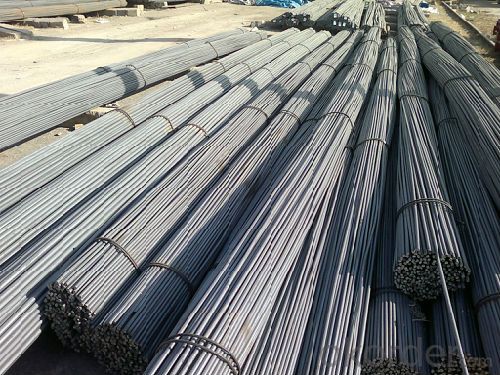
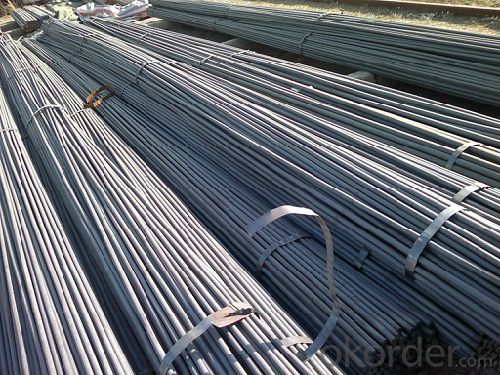
*If you would like to get our price, please inform us the size, standard/material and quantity. Thank you very much for your attention.
- Q: Can special steel be used in the power transmission industry?
- Yes, special steel can be used in the power transmission industry. Special steel alloys offer enhanced strength, durability, and resistance to wear and corrosion, making them suitable for various components in power transmission equipment such as gears, shafts, bearings, and connectors. These alloys can withstand high loads, extreme temperatures, and harsh environmental conditions, ensuring reliable performance and longevity in power transmission applications.
- Q: What are the requirements for special steel used in high-performance racing cars?
- The requirements for special steel used in high-performance racing cars are quite stringent in order to meet the demands of the racing environment. Some of the key requirements include: 1. Strength and Durability: Special steel used in racing cars must possess exceptional strength and durability to withstand the extreme loads and stresses experienced during high-speed racing. It should have a high tensile strength and be able to resist fatigue and deformation under intense conditions. 2. Lightness: Racing cars require materials that are lightweight to ensure optimal performance and maneuverability on the track. Special steel used in high-performance racing cars must have a high strength-to-weight ratio, allowing for reduced weight without sacrificing strength or safety. 3. Heat Resistance: The steel must have excellent heat resistance to withstand the high temperatures generated by high-performance engines, braking systems, and exhaust systems. It should be able to maintain its structural integrity and mechanical properties even under extreme heat conditions. 4. Corrosion Resistance: Racing cars are often exposed to harsh environments, including moisture, salt, and other corrosive elements. Therefore, special steel used in racing cars should have high corrosion resistance to prevent rust and degradation, ensuring the longevity and reliability of the components. 5. Machinability: The steel should be easily machinable, allowing for precise manufacturing and fabrication of complex components. This ensures that the parts can be accurately and efficiently produced, resulting in superior performance and reliability. 6. Weldability: Special steel used in racing cars should have good weldability, as welding is often necessary for the assembly of various components. It should be able to withstand the heat generated during welding without experiencing significant loss in strength or other mechanical properties. Overall, the requirements for special steel used in high-performance racing cars revolve around strength, lightness, heat resistance, corrosion resistance, machinability, and weldability. Meeting these requirements is crucial to ensure the safety, performance, and success of racing cars on the track.
- Q: How is special steel used in the production of gears?
- Special steel is used in the production of gears due to its high strength, durability, and resistance to wear and fatigue. It provides the necessary toughness and hardness required to withstand the stresses and loads that gears experience during operation. Additionally, special steel can be heat treated to enhance its properties, ensuring precise dimensions and improving the overall performance and lifespan of gears.
- Q: What are the different corrosion protection techniques used for special steel?
- There are several corrosion protection techniques used for special steel, including: 1. Coatings: Special steel can be coated with a variety of protective materials such as paints, epoxy, or other barrier coatings. These coatings act as a physical barrier between the steel and corrosive elements, preventing direct contact and potential damage. 2. Cathodic protection: This technique involves the use of sacrificial anodes or impressed current systems to protect the steel. Sacrificial anodes, typically made of zinc or aluminum, corrode instead of the steel, sacrificially protecting it. Impressed current systems use an external power source to provide a protective current that prevents corrosion. 3. Galvanization: Special steel can be hot-dip galvanized by immersing it in molten zinc. This creates a protective layer on the surface of the steel, significantly increasing its resistance to corrosion. 4. Alloying: Alloying the special steel with specific elements can enhance its corrosion resistance. For example, adding chromium to the steel can create a passive oxide layer that acts as a protective barrier against corrosion. 5. Passivation: Special steel can undergo passivation, a chemical process that removes free iron and other contaminants from the surface, promoting the formation of a protective oxide layer. Each of these techniques can be tailored to suit the specific requirements of the special steel and its intended application, providing effective corrosion protection and prolonging the lifespan of the material.
- Q: What are the main applications of special steel in the semiconductor industry?
- Special steel finds various applications in the semiconductor industry, primarily in the manufacturing of critical components such as chambers, wafer carriers, and vacuum systems. Due to its high strength, corrosion resistance, and thermal stability, special steel is ideal for creating these parts that require durability and precision in maintaining the controlled environments necessary for semiconductor production. Additionally, special steel is also used in the fabrication of cutting tools and molds for semiconductor device manufacturing, further highlighting its importance in this industry.
- Q: What are the different joining processes for special steel?
- There are various joining processes for special steel, including welding, brazing, and soldering. Welding involves melting the steel and fusing it together, while brazing uses a filler metal with a lower melting point to join the steel parts. Soldering, on the other hand, uses a lower melting point alloy to create a bond between the steel pieces. Each process has its own advantages and limitations, and the choice depends on factors such as the type of steel, the desired strength of the joint, and the application requirements.
- Q: What is the impact of carburizing on the properties of special steel?
- Carburizing has a significant impact on the properties of special steel. It improves the surface hardness and wear resistance of the steel by introducing carbon into its surface layer. This process creates a hardened case while maintaining a tough core, enhancing the steel's overall strength and durability. Additionally, carburizing enhances the steel's ability to withstand high temperatures and increases its resistance to corrosion. Overall, carburizing plays a crucial role in enhancing the mechanical properties of special steel, making it suitable for various applications in industries such as automotive, aerospace, and manufacturing.
- Q: What are the different methods of hardening special steel?
- There exist various techniques for strengthening special steel, each possessing its own merits and suitable applications. 1. Quenching: A widely employed approach for steel hardening, it entails heating the steel to a critical temperature and rapidly cooling it in a quenching medium such as oil, water, or air. This rapid cooling prompts the formation of a martensitic structure, rendering the steel harder but more brittle compared to its original state. 2. Tempering: Following quenching, steel is often subjected to tempering to decrease brittleness and enhance toughness. This process involves reheating the hardened steel to a specific temperature and maintaining it at that temperature for a predetermined duration. By doing so, internal stresses are reduced, and the overall mechanical properties of the steel are improved. 3. Case hardening: Employed to augment the hardness of the outer layer of steel while preserving a tough and ductile core, case hardening involves introducing carbon or nitrogen into the steel's surface through methods like carburizing or nitriding. This results in the creation of a hardened surface layer while retaining the desired properties within the core. 4. Induction hardening: Particularly useful for localized hardening of specific regions within a component, this technique employs an electromagnetic field to solely heat the desired area of the steel, followed by rapid quenching. Induction hardening allows precise control over the hardened region while maintaining desired properties in the remainder of the component. 5. Cryogenic treatment: Involving subjecting hardened steel to extremely low temperatures, often below -150°C (-238°F), this process further refines the steel's microstructure, enhancing its hardness, wear resistance, and dimensional stability. 6. Flame hardening: This method entails heating the steel's surface using a high-temperature flame and subsequently quenching it. Flame hardening is typically employed for large components or specific areas requiring localized hardening. Selecting the appropriate method is crucial and dependent on the steel's specific requirements and intended application. Factors such as desired hardness, toughness, wear resistance, and dimensional stability play a pivotal role in method selection.
- Q: How does mold steel resist wear and erosion?
- Mold steel resists wear and erosion due to its high hardness and toughness properties. The steel is specifically designed to withstand the repetitive stress, abrasion, and impact that molds are subjected to during their operational lifespan. Additionally, mold steel is often treated with heat treatments or coatings to further enhance its resistance to wear and erosion, ensuring its durability and longevity in molding applications.
- Q: What are the different methods of improving the toughness of special steel?
- To enhance the toughness of special steel, various techniques can be utilized. One effective method involves the addition of alloying elements such as nickel, chromium, or manganese to the steel composition. These elements contribute to increased strength and resistance to cracking or fracturing. Another approach is to apply heat treatment processes like quenching and tempering. Quenching rapidly cools the steel from a high temperature, resulting in a hardened structure. On the other hand, tempering involves reheating the quenched steel to a specific temperature and then slowly cooling it. In addition, grain refinement techniques can be employed to improve toughness. Controlling the size and distribution of grains within the steel enhances its resistance to fracture. Methods like grain size control through recrystallization and severe plastic deformation can be used to refine the grain structure. Furthermore, maintaining low impurity content in the steel is crucial for its toughness. Impurities like sulfur and phosphorus can cause brittleness, so refining and purification processes should be employed to reduce their presence. Moreover, surface treatment methods such as shot peening or surface hardening can be implemented. Shot peening involves bombarding the steel surface with small spherical particles to induce compressive stress, which helps in resisting crack propagation. Surface hardening techniques like carburizing or nitriding create a hardened layer on the surface, enhancing toughness. In conclusion, improving the toughness of special steel can be achieved through alloying, heat treatment, grain refinement, impurity control, and surface treatment. These techniques can be used individually or in combination to enhance the steel's properties and make it more resistant to cracking or fracturing.
Send your message to us
High Quality Spring Steel Round Bar 8-10mm
- Loading Port:
- China main port
- Payment Terms:
- TT or LC
- Min Order Qty:
- 100 m.t
- Supply Capability:
- 10000 m.t/month
OKorder Service Pledge
OKorder Financial Service
Similar products
Hot products
Hot Searches
Related keywords
